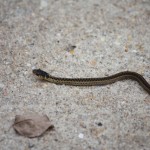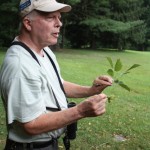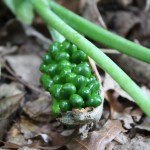An Illuminating Nature Walk!

It was such a hot and humid morning for our Nature Walk led by naturalist Tom Reeves on August 4, even the wildlife seemed to protest by staying hidden. So after spotting a baby Common Garter snake at the main entrance, Tom used his seemingly encyclopedic knowledge to teach 15 of us about plants and other interesting organisms in Glen Providence Park! We learned that lichen is actually a dual organism made of fungus and algae– and as it is sensitive to pollution, the lichen in the park indicates clean air!
Glen Providence Park is full of plants with interesting features, including the wintergreen smell of the Cherry birch and the turpentine smell of the White pine. The park’s abundant Spicebush has a spicy aroma and can be used for tea, and our native Witch hazel can be used to make… witch hazel!
Tom taught us that trees are named for their flower parts, not their leaf shapes, leading to some counterintuitive classifications. Trees we discussed include Basswood, White ash, Black oak, White mulberry, Hemlock, and Box elder. How do you tell a spruce from a fir? If you roll a “sharp” spruce needle between your fingers, you will find that it is square, with sharp tips. The “friendly” fir needle is flat, without sharp tips.
Our abundant American beech tree has a couple of interesting features, including that vines cannot grow up its smooth bark. And it hosts Tom’s favorite plant, the hard to spot Beech-drop, Epifagus americana– a parasitic plant that grows in the roots of beeches. The Beech-drop blooms from August to October, so we will look out for that!
Alas, pesky Poison ivy has grown stronger (and itchier!) in the past 20 years due to increasing carbon dioxide levels! So we weren’t just imagining it… Fortunately, 34 bird species like to dine on poison ivy berries- rich with oil and called “chocolate cake for birds”. Another park nuisance, the invasive Multiflora rose was once encouraged by PennDOT as desirable ground cover!
Tom pointed out that predator mammals have eyes in front of the head, whereas prey mammals have eyes on the side of the head- just compare deer to wolves! Predators look forward to stalk their prey, and the prey needs a wide field of vision to spot predators. He also taught us the handy trick of using binoculars in reverse as a magnifying glass! It was hard to take notes fast enough- this is just a sampling of what we learned.
Tom ended by telling us about becoming a birder on his fourth grade field trip to Glen Providence Park. He said the donation from his church, Reformation Lutheran Church, for our Earth Day Plantings was like coming full circle. We were honored to share a walk in Glen Providence Park with him!
Thank you to Tom Reeves for an illuminating walk, and to those who attended on such a hot August morning!
Scroll through the event photos below for a virtual tour of a few things we spotted…
- Baby Common Garter snake
- Tom Reeves
- Puffball mushroom
- Beech-drop
- Spider
- Jack in the Pulpit berries













Recent Comments